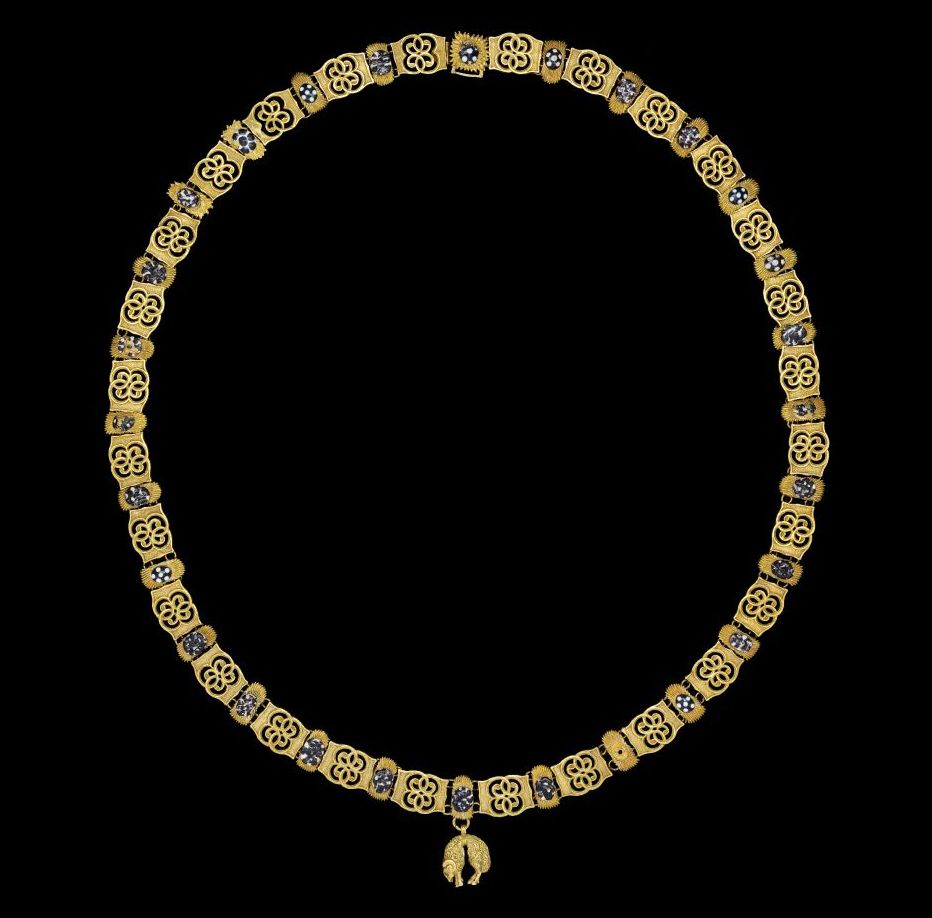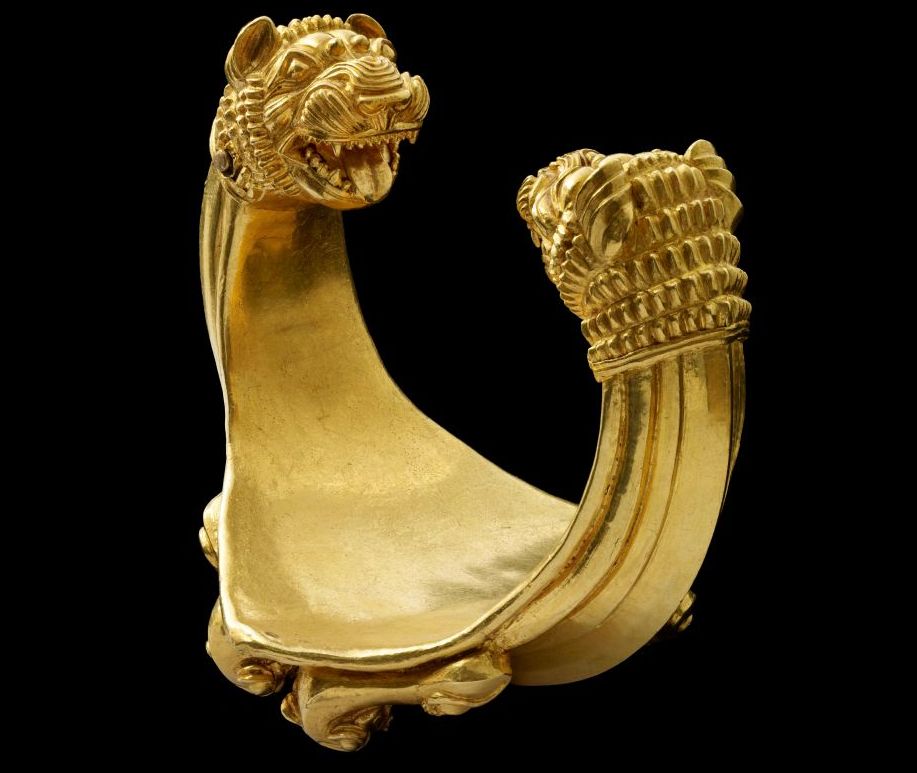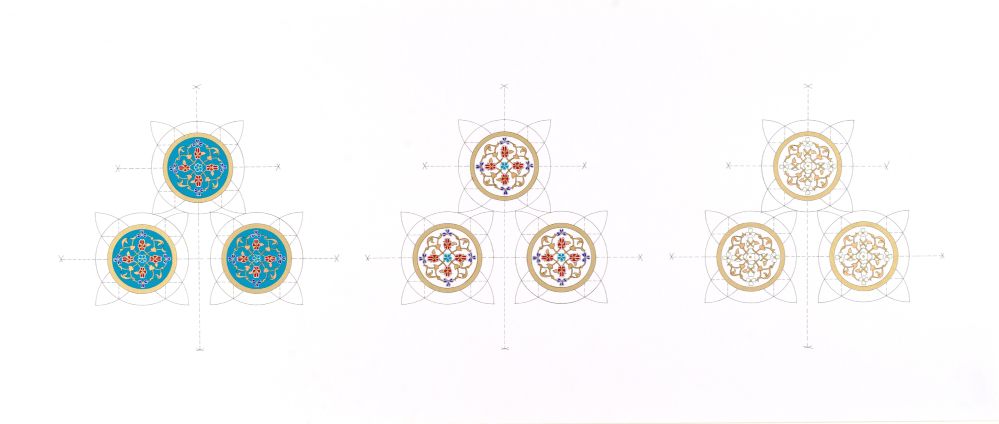Golden treasures
Collar of the Order of the Golden Fleece. Flanders (today northern France, Belgium and the Netherlands) 1500–1600 L. 118 cm; gold and enamel Louvre Abu Dhabi, Image credit: © Department of Culture and Tourism – Abu Dhabi. Photo: Thierry Ollivier.
Founded in Bruges in January 1430 by Philip the Good, the Order of the Golden Fleece gathered around the Duke of Burgundy a group of loyal knights entirely obedient to his will and committed by its statutes to mutual love, aid and fraternity. As a pledge of obedience and loyalty, they wore the insignia they received on their investiture, the collar of the Golden Fleece, every day. The order’s name refers either to the golden fleece sought by Jason, as recounted by Apollonius of Rhodes, or the fleece laid out on the ground by Gideon in the Bible. This collar belonged to Adrien de Croÿ (c. 1500–53), one of the faithful counselors of Charles V, Holy Roman Emperor and Duke of Burgundy, who bestowed it on him in 1519.

Collar of the Order of the Golden Fleece. Flanders (today northern France, Belgium and the Netherlands) 1500–1600 L. 118 cm; gold and enamel Louvre Abu Dhabi, Image credit: © Department of Culture and Tourism – Abu Dhabi. Photo: Thierry Ollivier.
Iconography and style, this masterpiece of jewelry encapsulates the artistic synthesis that began in northwest Iran during the 8th century BCE, when craftsmen at the service of local rulers drew upon influences ranging from the Assyrian empire in the west to the kingdom of Urartu and the Scythian tribes in the north. Discovered by chance by villagers in 1947, the bracelet is from an isolated tomb located above the village of Ziwiyé in the hills of Kurdistan. A wealthy person had been buried there at the very beginning of the 7th century BCE in a bronze sarcophagus, together with articles of finery in silver and gold, precious vessels and ceremonial articles.

Lion bracelet. Iran, Ziwiye 800–600 BCE Diam. 9.5 cm, gold.
Louvre Abu Dhabi.
Image credit: © Department of Culture and Tourism – Abu Dhabi.
Photo: Thierry Ollivier.
The treasure included two striking gold bracelets, this one and its exact counterpart now in the museum of Tehran. Forming part of the long Iranian tradition of art with animal motifs, they constitute a virtuoso technical feat and an aesthetic manifesto at the same time. The body consists of a thick, gold bangle with moldings that enhance the glow of the metal. It broadens in the middle of the curve to take the form of a lozenge on which two pairs of impassive lion cubs recline on either side of the center line. The ends of the bracelet are in the form of menacing, bare-fanged lion heads that generate dynamic tension and contrast sharply with the hieratic pose of the cubs. Only a powerful ruler could boast such finery. Was he a Mannaean king or a Median ruler, as certain scholars suggest? It is impossible to know in the absence of any archaeological context. In any case, with its form and stylized treatment, this bracelet heralds the later masterpieces of Achaemenid Persian jewelry.
The first bracelets with animal decorations at both ends appeared in northwest Iran at the end of the 2nd millennium BCE. While they soon came to enjoy great popularity, few can claim to be authentic masterpieces, as this one is.
Lion cubs are a very rare motif in the art of the ancient Near East, and in Iranian art in particular. Their hieratic character, enhanced by the symmetry, suggests that they can be regarded here as apotropaic figures, comparable to the lions that guarded cities, temples and palaces to protect them from harmful influences and external enemies.
A monument of expressive power, this roaring and threatening lion’s head is detachable, being held in place by a small pin that could be removed to allow the hand through. The imposing size of the bracelet and the complexity of its decoration are such as to endow it with an almost sculptural quality and suggest that it should be regarded as an article of finery that was probably seldom worn. The lion was accorded pride of place among wild animals in the imagination of the ancient Near East. This fearsome and majestic predator is sometimes associated with certain divinities like Ishtar, the Mesopotamian goddess of love and war, but also with the expression of regal power. Depicted on jewelry, ornaments and clothing, the noble beast magnified the power of the wearer.
An iconic image of the period of “barbarian invasions,” the Domagnano fibula is an exceptional piece in the Louvre Abu Dhabi collections. In a shimmer of gold and garnets from Gujarat in India, this sumptuous item of jewelry combines the ancient symbol of power of the eagle with the cross of the new Christian era. Dated at the end of the 5th century, it is probably contemporary with the fall of the last Roman emperor of the West and epitomizes the rich and complex period that saw the meeting of ancient, barbarian and Christian traditions.

Brooch in the form of an eagle. Italian peninsula, San Marino, Domagnano 450–500 CE H. 12.1, W. 6.4 cm, gold, garnet.
Louvre Abu Dhabi.
Image credit: © Department of Culture and Tourism – Abu Dhabi.
Photo: Thierry Ollivier.
This luxurious fibula, originally worn with its symmetrical counterpart on the shoulder of a woman’s robe, is in the majestic form of a bird of prey, probably a falcon, represented in full flight or perched on the hand of its owner. A circular medallion has a cross-shaped motif in the center.
The fibula illustrates the introduction of the new technique of cloisonné jewelry, a process imported from the areas north of the Black Sea by eastern Germanic peoples, possibly the Huns, whereby semi-precious stones and materials are inlaid in compartments made by soldering gold wires (more than 220 here) onto a flat piece of gold


